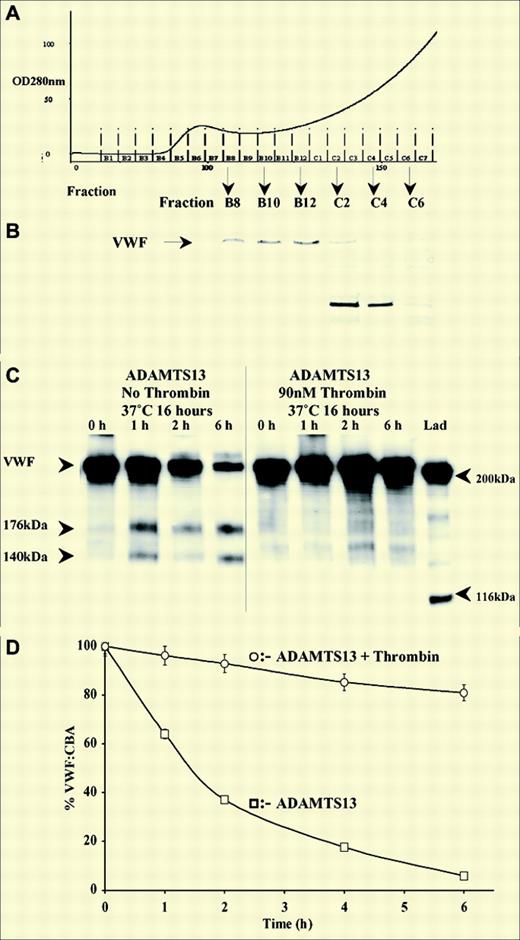Comment on Crawley et al, page 1085
Left unchecked, ADAMTS13 activity may inhibit platelet adhesion at sites of vascular injury under high shear stress. Crawley and colleagues present evidence that the proteolytic cleavage of ADAMTS13 by coagulation proteinases inhibits its ability to cleave von Willebrand factor.
Platelet adhesion to sites of vascular injury under high shear stress occurs as a 2-step process. Initial platelet rolling is mediated by transient interactions between the platelet membrane glycoprotein Ib-IX-V complex and surface-immobilized von Willebrand factor (VWF), and subsequent firm adhesion occurs following the stable binding of platelet integrin αIIbβ3 or collagen receptors to surface-immobilized VWF or collagens in the vascular subendothelium.1 In vitro, the interplay of VWF and fibrinogen during thrombus growth on a collagen surface under physiologic high shear stress has been extensively studied using a perfusion chamber and confocal laser microscopy. From these studies, it is now known that during the initial stages of thrombogenesis, platelet thrombi are entirely composed of plasma VWF, and platelet-derived fibrinogen accumulates predominantly inside the growing thrombi and acts as a core adhesive ligand. However, the thrombus surfaces exposed to flow are constantly occupied with VWF.2 The ability of VWF to bind forming thrombi is dependent on its multimeric size, ranging from 500 to 15 000 kDa. The multimeric state of VWF is regulated by the number of N-terminal intersubunit disulfide bonds formed in the Golgi complex as well as by proteolytic cleavage by ADAMTS13 (a disintegrin-like and metalloproteinase with thrombospondin type 1 motifs 13) in the circulation.3
ADAMTS13 is a Zn2+-binding metalloproteinase produced in the liver, and its 1427 amino acids form a multidomain structure. Recent studies have revealed that the catalytic or substrate recognition site resides on the metalloproteinase or cysteine-rich/spacer domain. Thus, the structure/function relationship of ADAMTS13 is becoming clear but the regulation of ADAMTS13 activity is entirely unknown. Possible clues to this regulation have been provided by 2 recent reports that showed that interleukin-6 abolishes ADAMTS13 activity solely under flow conditions4 and that a relatively high concentration of hemoglobin inhibits enzyme activity in a static assay system.5 The physiologic role of these proteins in normal hemostasis remains undetermined.FIG1
Proteolysis of ADAMTS13 by thrombin abolishes ADAMTS13 enzymatic activity toward purified human VWF. See the complete figure in the article beginning on page 1085.
Proteolysis of ADAMTS13 by thrombin abolishes ADAMTS13 enzymatic activity toward purified human VWF. See the complete figure in the article beginning on page 1085.
In this issue of Blood, Crawley and colleagues suggest a role for proteolytic cleavage in the inactivation of ADAMTS13. The 3 serine proteases (thrombin, Xa, and plasmin) used are ubiquitously involved in normal hemostasis. Using purified recombinant ADAMTS13 fused with a myc epitope and polyhistidine tag at the C-terminus, the authors used 2 monoclonal antibodies to the ADAMTS13 metalloproteinase domain as well as an anti-myc antibody to follow the proteolytic degradation of ADAMTS13 by Western blot. The ADAMTS13 fragments generated by these serine proteases were similar in size but not identical. Interestingly, ADAMTS13 activity decreased uniformly with increased proteolysis. Perhaps most interesting, thrombin-mediated proteolysis of ADAMTS13 was entirely inhibited following preincubation with soluble thrombomodulin (TM) but not heparin, implicating thrombin exosite I as a possible site of interaction with ADAMTS13. These data lead to a model in which TM, expressed on normal endothelium, inhibits the thrombin-mediated proteolysis of ADAMTS13. On denuded endothelium, however, the absence of TM would allow thrombin to inactivate ADAMTS13, facilitating the initial platelet adhesion process. Finally, because 3-dimensional models of mural thrombus formation suggest that the outer platelet surface is VWF rich,2 increased ADAMTS13 activity at sites distant from thrombin generation may ultimately control thrombus size. ▪


This feature is available to Subscribers Only
Sign In or Create an Account Close Modal